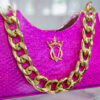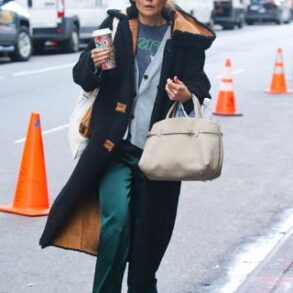When Singapore police executed simultaneous raids on premises across the city-state as part of a money laundering investigation last month, they seized more than a billion dollars’ worth of property and assets.
Along with cash, luxury cars, designer handbags, wine, jewellery and watches was a collection of about 60 colourful, mostly plastic figurines in the shape of a pot-bellied bear.
Limited edition runs of Bearbricks — produced by a Japanese toy company often in collaboration with well-known designers and brands — are much-sought after by collectors and fashionistas.
High-value, easily transportable and unregulated, they’re also an ideal vehicle for money laundering, experts say.
What are Bearbricks?
First produced by Japanese toy maker Medicom Toy in 2001 as a giveaway during the World Character Convention in Tokyo, Bearbricks are “designer toys” released as series with 18 figures in each representing a different theme such as “cute”, “animal”, “pattern” or “artist”.
They have long had an association with streetwear and “sneaker heads” thanks to early collaborations with brands like Stussy and Nike and graffiti artists such as KAWS and Futura.
But over the years, Medicom has touched seemly every corner of contemporary culture for inspiration — films, music, the arts and even high fashion — with contributions from such diverse creatives as HR Geiger to Vivienne Westwood.
Famous collectors include musician Pharrell Williams, filmmaker and actor Seth Rogen and the BTS rapper RM.
Loading Twitter content
While always basically the same form factor, Bearbricks come in a variety of sizes expressed as a percentage in relation to the standard “100 per cent” model, which stands 7 centimetres tall.
Common sizes are 400 per cent (28cm tall) and 1,000 per cent (70cm tall).
They also sometimes use materials other than the standard plastic, including wood and chrome.
Sold in “blind boxes” so buyers don’t know what they have until they open the packaging, rarer Bearbricks — sometimes produced in runs of only a few hundred — are frequently bought and sold on the secondary market, often for stratospheric prices.
Among the most sought-after are a series of Coco Chanel Bearbricks designed in 2006 for charity by Karl Lagerfeld, one of which was reportedly auctioned off by Sotheby’s in 2020 for about $60,000.
However, the highest price paid for a single Bearbrick is believed to be for a one-off design by Chinese contemporary artist Yue Minjun released in 2008 which sold at auction for about $250,000.
Shawn Wee, owner of Singapore collectibles store Eye For Toys, told the Straits Times the collection of Bearbricks seized by the Singapore police last month could be worth between $500,000 and $570,000 and appeared to be authentic.
“The most expensive of the lot belongs to the Pinel x Kongo set of eight pieces, at $343,000,” he said.
Other media reports have put the possible value as high as $1,144,000.
However, the proprietor of a Melbourne collectibles store, who declined to be identified, estimated the total price to be lower between $200,000 to $250,000 all up.
He said it was a rough estimate without knowing the condition of each figurine.
“The Bearbrick market has dropped significantly in the last six to 12 months due to the economy and over saturation in the market,” he added.
‘I just collected the ones that I liked’
Melbourne wedding photographer and Bearbricks collector Silas Chau bought his first Bearbricks in about 2019 after hearing about them from friends.
“I just collected the ones that I liked,” he said.
He started off buying Bearbricks made in the style of Daruma dolls and Lucky Cats, which are traditional Japanese figurines.
“At the time it was sort of like investing where it was like, if you don’t like it, you could always sell it and just get a different one because the value held back then, but the value has dropped quite a bit since the hype died.”
He said one of his first Bearbricks — a handpainted Daruma-style figurine made of wood — cost about $4,000.
He now has seven of the 1,000 per cent Bearbricks and and “a bunch” of 400 per cent.
“You just kind of feel happy when you see them,” he said.
Mr Chau estimated he had spent about $40,000 on his collection, but said its value had likely depreciated.
His most valuable Bearbrick — a ghillie suit-wearing 1,000 per cent figurine designed by Japanese clothing brands Readymade and BAPE — cost $18,000 but was now probably worth about $10,000, he said.
“I guess it’s a good time to buy.”
He added they were much more popular in Asia than in Australia.
“I went to Hong Kong recently and you see them everywhere in all the shops.”
Money laundering allegations
The Singapore police arrested nine men and one woman during the raids on August 15 and charged them with offences including forgery, money laundering, and resisting arrest.
“The police received information of possible illicit activities including the use of suspected forged documents that were used to substantiate the source of funds in Singapore bank accounts,” a statement said.
The group was “suspected to be involved in laundering the proceeds of crime from their overseas organised crime activities”.
Police say they were involved in scams, remote gambling in the Philippines and unlicensed moneylending in China.
The suspects are all foreigners with a variety of citizenships — China, Vanuatu, Cambodia, Turkey and Cyprus — but all originally come from China.
They were denied bail and remanded in custody until at least September 6 after appearing in court again on Wednesday. None have yet entered a plea.
Why Bearbricks are useful for money laundering
Jamie Ferrill, the head of financial crime studies at Charles Sturt University, said the purpose of money laundering was to obscure the trail between money and its illicit source.
“This is usually done via a web of transactions,” she said.
“If large amounts are used at once in regulated industries, it creates a direct line between the criminal and where the money went.
“It makes it too easy for law enforcement.”
Dr Ferrill said the high value of luxury goods made them useful for money laundering.
“If a Bearbrick is worth, say, $100,000, the money launderer can purchase it with their dirty money with relatively little suspicion,” she said.
“It appears legitimate; collectors do it every day.
“They do this over and over with varying amounts for various items, usually from different bank accounts/shell companies/cryptocurrency.
“They can build up a nice collection with these high-worth goods and eventually sell them.
“Often, the value of the good goes up if they made a good investment, and they can sell it at a profit.
“Since it was, for all intents and purposes, a legitimate purchase, the profit also appears legitimate.”
Another valuable attribute of luxury goods is that they are transportable, Dr Ferrill said.
“It is easier to move a handbag or a smaller Bearbrick across borders than it is a house or car,” she said.
“Moving these goods across borders adds more strands to that complex web and obscures the money trail even further.”
Dr Ferrill added that collectibles were an unregulated good in most jurisdictions, which made it even easier.
“Auction houses and luxury goods dealers do not have to report suspicious activity under the anti-money laundering/counter-terrorism financing regime, which is one of the many reasons the industry is often targeted.”
Australian National University lecturer Anton Moiseienko, whose work focuses on transnational crime, economic crime and cybercrime, agreed it made “perfect sense” for money launderers to invest in luxury items and collectibles such as Bearbricks.
Buying and selling such items distanced the funds from the initial crime, but also made moving value internationally easier.
“Instead of making a bank transfer and running the risk of detection, one may simply take some jewellery across the border,” he said.
He said gold, precious metals, jewellery and artworks were all well suited to this purpose but items like luxury handbags and collectible toys had a particular advantage.
“Businesses that buy and sell them are normally not subject to anti-money laundering regulation, unlike gold dealers or art auction houses, which means they do not need to report suspicious customers or activities,” Dr Moiseienko said.
“From a money launderer’s perspective, that’s the sweet spot: expensive, highly liquid goods in an unregulated market.”
However, he added that purchasing goods with the proceeds of crime was illegal and those items could still be confiscated by police.
“The line between the legal and the legal is not the nature of the transaction, but where the money comes from,” he said.







